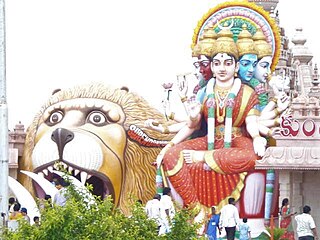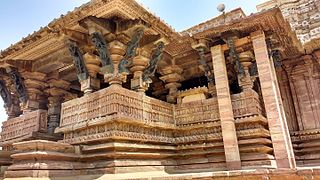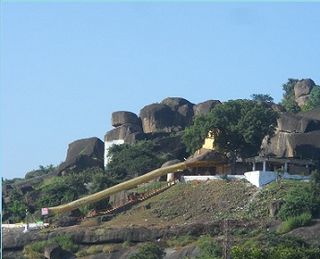
Parshvanatha, or Pārśva and Pārasanātha, was the 23rd of 24 Tirthankaras of Jainism. He gained the title of Kalīkālkalpataru.

Padmāvatī is the protective goddess or śāsana devī (शासनदेवी) of Pārśvanātha, the twenty-third Jain tīrthāṅkara, complimenting Parshwa yaksha in Swetambara and Dharanendra in digambar the shasan deva. She is a yakshini of Parshwanatha.

Mangi-Tungi is a prominent twin-pinnacled peak with plateau in between, located near Tahrabad about 125 km from Nashik, Maharashtra, India. Mangi, 4,343 ft (1,324 m) high above sea level, is the western pinnacle and Tungi, 4,366 ft (1,331 m) high, the eastern. Mangi-Tungi is 30 km (19 mi) from the city of Satana.

Nagaraja Temple is an early large temple found in the city of Nagercoil (Nagarkōyil) near the southern tip of Tamil Nadu, India. Its dating is uncertain but likely pre-12th-century. The main sanctum is dedicated to the Nagaraja – the king of serpents. Padmanabham (1985), Heritage Of The Tamils Temple Arts, Editors: SV Subramanian and G Rajendran, International Institute of Tamil Studies, Since the 17th-century, new Hindu shrines have been added to the temple complex attracting devotees of Krishna (Vishnu), as well as Shaiva and Shakti Hindus. The original iconography of the Tirthankaras and Padmavati Devi have and continue to remain a part of the sacred pantheon close to the temple's main sanctum.
The Western Ganga Dynasty was an important ruling dynasty of ancient Karnataka. Its members are known as Western Gangas to distinguish them from the Eastern Gangas who in later centuries ruled over modern Orissa. The Western Gangas ruled as a sovereign power from the middle of fourth century to middle of sixth century, initially from Kolar, later moving their capital to Talakad on the banks of the Kaveri River in modern Mysore district. Though territorially a small kingdom, the Western Ganga contribution to polity, culture and literature of the modern south Karnataka region is considered noteworthy. The Ganga kings showed benevolent tolerance to all faiths but are most famous for their patronage towards Jainism resulting in the construction of fine monuments in such places as Shravanabelagola and Kambadahalli.

The Sri Lakshmi Narasimha Swamy Temple or simply known as Yadadri or Yadagirigutta temple, is a Hindu temple situated on a hillock in the small town of Yadagirigutta in the Yadadri Bhuvanagiri district of the Indian state of Telangana. Yadadri temple is touted as Telangana's own Tirupati. The temple is dedicated to the god Narasimha, an avatar of Vishnu.

Jainism in North Karnataka flourished under the Chalukyas, Kadamba, Rashtrakutas, and Vijayanagara Empire. Imbued with religious feeling, patronage was extended towards the building of Jain temple and it garnered high repute among the people, particularly the ruling classes and the mercantile community; effectively getting treated as the state religion.

Surendrapuri is a religious tourism destination located near Hyderabad, Telangana, India in the Yadadri Bhuvanagiri district. The 17-acre religious complex includes the Kunda Satyanarayana Kaladhamam - India's first mythological museum, Panchamukha Hanumadeeswara Devasthanam (Hindu temple), Navagraha temples, Nagakoti idol, and Surendrapuri’s iconic two-sided Panchamukha Hanuman-Shiva statue.

Alair is a town in Yadadri Bhuvanagiri district of the Indian state of Telangana. It is a municipality and one of the constituencies in the Yadadri Bhuvanagiri district. It is located in Alair mandal of Bhongir revenue division. Alair is known for its Kulpakji Jain temple, and also known as the birthplace of Renukacharya, one of the five acharyas who came in the Kali Yuga to teach and preach Vīraśaivism.

Jain sculptures or Jain idols are the images depicting Tirthankaras. These images are worshiped by the followers of Jainism. The sculpture can depict any of the twenty-four tirthankaras with images depicting Parshvanatha, Rishabhanatha, or Mahāvīra being more popular. Jain sculptures are an example of Jain art. There is a long history of construction of Jain sculptures. Early examples include Lohanipur Torsos which has been regarded to be from the Maurya period, and images from the Kushan period from Mathura.

Jina Kanchi Jain Math, Melsithamur, is a Jain Matha that is located near Gingee, Villupuram district, Tamil Nadu, India.

Aranath(Arnath) was the eighteenth Jain Tirthankar of the present half cycle of time (Avasarpini). He was also the eighth Chakravartin and thirteenth Kamadeva. According to Jain beliefs, he was born around 16,585,000 BCE. He became a siddha i.e. a liberated soul which has destroyed all of its karmas. Aranath was born to King Sudarshana and Queen Devi (Mitra) at Hastinapur in the Ikshvaku dynasty. His birth date was the tenth day of the Migsar Krishna month of the Indian calendar.

The earliest temples in Telangana include the Alampur Navabrahma Temples built during the 6th century CE by the Badami Chaulukyas.
The Telangana State Tourism Development Corporation is a state government agency which promotes tourism in Telangana, a state in the Southern region of India. The retired Director General of Police Pervaram Ramulu is the appointed First chairman of Telangana State Tourism. Tourist attractions in Telangana include historical places, monuments, forts, water falls, forests and temples.

Padmakshi Temple is one of the oldest temples in the Hanamakonda area of Telangana, India. It is dedicated to the Hindu goddess Padmakshi (Lakshmi), and also features Jain imagery.

Kankali Tila is a mound located at Mathura in the Indian state of Uttar Pradesh. The name of the mound is derived from a modern temple of Hindu goddess Kankali. The famous Jain stupa was excavated here in 1890-91 by Alois Anton Führer.

Warangal district, formerly Warangal Rural district, is a district in the Indian state of Telangana. The district shares boundaries with Mahabubabad, Jangaon, Hanamkonda, Mulugu and Bhupalpally districts.
Pakbirra is a village in the Puncha CD block in the Manbazar subdivision of the Purulia district in the state of West Bengal, India.

Bommalagutta is a Jain centre situated near Kurikyala village of Karimnagar district in Telangana. This Jain center is situated 3 km from another famous Jain center Kulpakji.

The Ahichchhatra Jain temples is a group of Jain temples in Ahichchhatra village in Aonla tehsil of Bareilly district in Uttar Pradesh, North India. Ahichchhatra is believed to be the place where Parshvanatha, the 23rd Tirthankar of Jainism, attained Kevala Jnana.






















